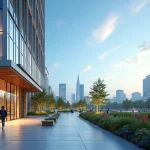Real estate development transforms ideas into tangible spaces by managing land, financing, construction, and marketing. It demands balancing risks and coordinating diverse experts to shape urban growth. Understanding each stage reveals how developers turn raw land or existing properties into thriving communities, adapting to evolving market trends and regulatory challenges for a sustainable future.
The Fundamentals of Real Estate Development
World’s Richest Entrepreneurs often cite real estate development as a cornerstone of wealth accumulation, underscoring its significance in the global economy.
Have you seen this : Transform your business with innovative commercial solar panels
This sector encompasses the comprehensive process of transforming land and properties into profitable assets—serving as the foundation of modern urban landscapes. The core activities involve land acquisition, which sets the stage for subsequent steps such as planning, construction, marketing, and eventual sales or leasing.
Developers play a pivotal role in orchestrating this complex process. They coordinate a diverse array of stakeholders including architects, city officials, financiers, and contractors, each contributing essential expertise. Their responsibilities extend from securing permits to managing construction timelines, ensuring regulatory compliance, and overseeing financial arrangements.
Have you seen this : Elevate your outdoors with expert garden designers today
The development process is inherently risk-laden. Financial risks are amplified by leverage and long project durations. Consequently, meticulous risk management is indispensable, often utilizing spatial intelligence tools that predict demographic shifts and population trends. These innovations assist developers in assessing location suitability, thus reducing uncertainties associated with land development and urban growth.
Commercial and residential projects differ notably in scale, complexity, and stakeholder engagement, yet both require a personalized touch, especially when integrating sustainable building practices and community engagement strategies. Large firms emphasize their global expertise; however, whether focusing on urban renewal or mixed-use developments, the primary goal remains to maximize value and social impact.
You can view more details on this page: World’s Richest Entrepreneurs
Phases of Real Estate Development and Critical Processes
Concept and Feasibility Planning
The property development lifecycle begins with precise market analysis for property development and strategic site acquisition process. Specialists in urban planning and design initiate this by reviewing economic factors affecting development and applying data-driven market demand forecasting to pinpoint locations suited to residential and commercial projects. To ensure viability, a thorough development feasibility study is conducted. This study evaluates both projected returns and risks, integrating environmental impact assessment to address sustainability goals.
Site acquisition also relies on robust land acquisition strategies, prioritizing locations that optimize land use and support infrastructure planning and integration. Legal compliance is central, requiring attention to zoning laws and regulations and alignment with master planning for developments. Feasibility assessments factor in potential challenges, including regulatory compliance in development and the need for development permits and approvals, coupled with understanding community impact assessment results to support stakeholder engagement in development.
Financing and Approval Stages
Unlocking a project’s potential involves establishing diverse real estate finance and funding options. Developers pursue financing options such as mortgages, syndicating investments, and forming public-private partnerships in development. Real estate joint ventures and infrastructure investment planning often bolster risk management in property projects, spreading exposure across partners and aligning interests as projects advance through the property development lifecycle.
Obtaining necessary approvals brings its own complexity. Projects must meet strict real estate legal considerations, which address land use planning policies and the intricacies of building code adherence. Development permits and approvals are contingent on robust stakeholder engagement in development, especially for neighborhood revitalization projects or mixed-use development trends. Effective engagement helps mitigate displacement and gentrification issues, strengthening community development and engagement outcomes and safeguarding against unnecessary project delays.
Construction and Project Management
As projects transition to the build phase, construction project management becomes crucial. Detailed construction timeline and scheduling minimize disruptions and ensure deadlines are met. Selecting construction methods and materials is paramount, especially as innovative construction methods and sustainable building practices are adopted in response to urban renewal initiatives and urban density and growth management concerns.
Attention to construction quality control ensures high standards are maintained, while integrating sustainable building practices targets certifications such as green building certifications. The integration of digital technologies in development, including real estate development software tools and building information modeling, streamlines project delivery methods, supports real-time cost control, and enhances communication.
Materials and technologies used during construction must align with both energy efficiency in new builds and the project’s economic impact. Leadership and effective project budgeting and cost control steer residential and commercial projects from concept to completion, laying the foundation for long-term property management integration and resale or leasing strategies.
Each phase—from market analysis for property development through community engagement and construction—demands continuous assessment and adaptation to project requirements, emerging trends, and the evolving needs of the development site and wider community.
Land Acquisition, Development Strategies, and Stakeholder Engagement
Land Purchase and Zoning Compliance
Real estate development begins with a thorough site acquisition process, where developers evaluate land using market analysis for property development to identify areas with growth potential or strategic value. Land acquisition strategies vary: some projects benefit from direct purchase; others require assembling multiple parcels or leveraging real estate joint ventures, which spread risk and pool resources. Throughout this stage, strict adherence to zoning laws and regulations is non-negotiable—regulatory compliance in development not only secures project viability, but also influences subsequent financing options for developers.
Developers rely increasingly on digital technologies in development, such as geographic information systems, to model demographic trends and urban density, which supports both site selection and planning. Addressing legal considerations, including subdivision and development permits and approvals, is essential for regulatory compliance and risk management in property projects. Spatial intelligence tools also aid in land use optimization, assessing whether sites are best suited for residential and commercial projects or industrial developments.
Community and Stakeholder Collaboration
Stakeholder engagement in development is paramount. Developers coordinate with local authorities, residents, and investors to build public-private partnerships in development projects and ensure that infrastructure planning and integration serve community needs. Community development and engagement foster local support, reduce project opposition, and can accelerate approval timelines.
Environmental impact assessment and community impact assessment are often required by policy and best practice. These studies address both immediate and long-term repercussions of the property development lifecycle on residents and ecosystems, feeding directly into project design and permitting. Developers may also conduct neighborhood revitalization projects or urban renewal initiatives as part of broader urban regeneration models, ensuring that sustainable building practices and green infrastructure integration are embedded from the outset.
Value Addition and Property Optimization
Once land is acquired and stakeholders are aligned, adding value becomes the focus. Adaptive reuse of buildings—transforming underutilized sites or structures into vibrant mixed-use developments or affordable housing developments—can drastically improve property value and neighborhood livability. Construction project management teams examine construction timeline and scheduling to control costs, while also employing innovative construction methods and modular construction benefits to enhance efficiency.
Optimizing property means aligning with real estate market trends analysis; developers assess which upgrades (from energy efficiency in new builds to market-driven amenities) will yield the highest returns. Construction materials and technology, when chosen with sustainability and property valuation techniques in mind, further solidify a project’s market appeal.
In summary, successful real estate development leverages robust urban planning and design, thorough risk management in property projects, and close stakeholder collaboration. These practices, when integrated with current financing options for developers and environmental sustainability goals, produce residential and commercial projects that drive economic benefit, urban renewal, and long-term community well-being.
Market Trends, Challenges, and Future Outlook in Real Estate Development
Current Market Dynamics and Investment Strategies
In today’s property development landscape, urban planning and design shape both residential and commercial projects as developers respond to changing population patterns and evolving community needs. Developers increasingly rely on market analysis for property development to anticipate demand, manage the property development lifecycle, and identify locations with high potential. These analyses inform site acquisition process decisions and drive property investment strategies that align with local infrastructure planning and integration.
Interest rates, economic cycles, and global events play key roles in property investment strategies. Developers continuously evaluate economic factors affecting development, adjust project budgeting and cost control, and assess risk management in property projects—especially as construction project management approaches become more data-driven. The integration of digital technologies in development, such as virtual site tours and real estate development software tools, empowers stakeholders to engage in site planning and layout remotely, accelerating investment decisions and streamlining development pipeline management.
Sustainable building practices, including green infrastructure integration and green building certifications, have become essential across real estate market trends analysis efforts. Both commercial real estate transformation and residential ventures integrate energy efficiency in new builds and prioritize adaptive reuse of buildings. Stakeholder engagement in development now routinely involves environmental impact assessment and prioritizes affordable housing development and mixed-use development trends, reflecting a broader commitment to long-term community development and engagement.
Challenges and Regulatory Environment
Modern property projects consistently encounter complexities around zoning laws and regulations, development permits and approvals, and regulatory compliance in development. Navigating intricate land use planning policies and urban design standards is vital for legal project continuity. Community impact assessment and neighborhood revitalization projects introduce layers of stakeholder engagement in development—developers must balance regulatory requirements, community expectations, and the need for inclusive urban density optimization.
Delays and escalating construction costs present persistent obstacles. Effective construction timeline and scheduling, as well as mastery over construction materials and technology, are needed to meet sustainable building practices amid shifting standards. Legal considerations encompass construction contract types, construction law basics, and building code adherence. Developers mitigate risks by employing environmental sustainability goals, managing site remediation challenges, and adopting robust construction safety protocols.
The regulatory environment is fluid—urban renewal initiatives and master planning for developments reflect ambitious public-private partnerships in development aimed at urban mobility and development improvements. Developers use real estate legal considerations expertise to proactively avoid pitfalls and engage in risk management in property projects, while also addressing displacement and gentrification issues spurred by rapid urban change.
The Future of Property Development
Innovation drives the next era of real estate development. Modular construction benefits and innovative construction methods increase speed, minimize waste, and support scalable responses to market demand forecasting. Digital technologies in development, including AI-powered planning, real estate valuation models, and project delivery methods, provide greater accuracy in development feasibility studies and facilitate construction quality control through all stages of the property development lifecycle.
Smart cities and development initiatives are transforming commercial and residential landscapes, forging stronger connections between land use optimization, transit-oriented development, and infrastructure investment planning. These innovations deepen the value of community development and engagement, enabling real estate development firms to lead in both the sustainability and efficiency of future projects.
Environmental impact assessment, property redevelopment strategies, and affordable housing policies are increasingly fundamental as demographic shifts and stringent environmental sustainability goals dictate the market’s direction. Developers who master land acquisition strategies, optimize project financing structures, and embrace digital marketing for real estate will be at the forefront of this transformative landscape—reshaping urban density and growth management for the decades ahead.
Real Estate Development: Key Phases and Strategic Considerations
Property development unfolds as a detailed, phased process requiring comprehensive knowledge of urban planning and design, property investment strategies, and construction project management. The transformation from a conceptual idea to a tangible asset depends heavily on strong project planning and a nuanced understanding of regulatory requirements, especially zoning laws and regulations.
The Property Development Lifecycle
The property development lifecycle starts with the site acquisition process. Developers conduct market analysis for property development, weighing urban renewal initiatives, and identifying favorable locations through demographic and infrastructure planning and integration. Each potential site undergoes risk management in property projects, balancing upfront costs and expected value.
A robust development feasibility study is essential. This incorporates economic factors affecting development, market demand forecasting, and real estate finance and funding scenarios. This stage also factors in environmental impact assessment and land use optimization, securing development permits and approvals early to avoid legal obstacles later in the property development lifecycle.
Collaborative Coordination and Stakeholder Engagement
Success hinges on seamless stakeholder engagement in development. Experienced teams coordinate with architects, planners, contractors, and legal advisors to address real estate legal considerations and community development and engagement goals. Master planning for developments is increasingly vital, ensuring each step—site planning and layout, project budgeting and cost control, and infrastructure investment planning—is carefully managed.
Leadership must negotiate public-private partnerships in development and establish transparent communication channels. Digital technologies in development, such as real estate development software tools and virtual site tours, streamline workflow and enhance decision-making.
Sustainable and Innovative Approaches
Environmental sustainability goals are now integral. Sustainable building practices—from green building certifications to green infrastructure integration—address both regulatory compliance in development and investor expectations. Construction materials and technology are selected for their energy efficiency in new builds and adaptability to modular construction benefits and adaptive reuse of buildings strategies.
Construction timeline and scheduling, construction quality control, and construction safety protocols must be rigorously followed. Project delivery methods determine efficiency and ultimately the success of residential and commercial projects.
Financial Structures and Market Strategy
Developers must grasp the complexities of financing options for developers and project financing structures. Property valuation techniques and real estate valuation models guide profit expectations, while property tax implications and development marketing techniques help maximize returns.
Multiple exit strategies and ongoing market analysis for property development shield developers from shifts due to real estate market cycles or economic incentives for development. As projects move toward completion, property management integration ensures long-term asset performance, rounding off the property development lifecycle.
Through this coordinated, expert-driven process, developers lead projects that drive urban mobility and development, support community impact assessment, and establish vibrant, resilient built environments.











